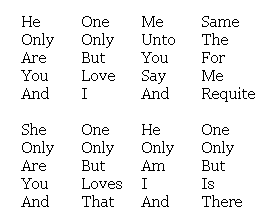vaccimulgence
n. the milking of cows
Language
True Enough
We have heard of the fall of Lucifer, and the fall of Cromwell, and the fall of Wolsey, but one of the pleasantest tumbles upon record was that of a Mr. John Fell, who, when he removed from one part of the metropolis to another, wrote over his door—I Fell from Holborn Hill.
— A Collection of Newspaper Extracts, 1842
Mouth Fun
Say aloud:
Whittle it a little, it’ll fit.
A noisy noise annoys a noisy Noyes.
The Icelandic sentence Barbara Ara bar Ara araba bara rabbabara, besides being fun to say, is spelled with only three letters. It means “Barbara, daughter of Ari, brought only rhubarb to Ari the Arab.” (Thanks, Sigurður.)
In a Word
xenodochial
adj. friendly to strangers
What?
If a train remains at the station from two to two to two-two (from 1:58 to 2:02), a passenger who misses it must wait from two-two to two to two.
Tom, while playing a game of Scrabble against Dick, who, while considering the last word that Harry (who had had HAD) had had had had, had had HAD, had had HAD. Had HAD had more letters, he would have played it.
Wouldn’t the sentence “I want to insert a hyphen between the words Fish and And and And and Chips in my Fish And Chips sign” have been clearer if quotation marks had been placed before Fish, and between Fish and and, and and and And, and And and and, and and and And, and And and and, and and and Chips — and after Chips?
Every spring, the town of March in Cambridgeshire holds a “long, flat, pointless walk” across the Fens to Cambridge. “It has no purpose other than to be called the March March march.” There is an associated song, which is sometimes called the “March March March March.”
“An Enigmatical Love-Letter Sent to a Young Lady”

— The Nic-Nac; or, Oracle of Knowledge, March 29, 1823
In a Word
pharology
n. the study of lighthouses
Alacke, What Noyse Is This?
WILLIAM SHAKESPEARE is an anagram of I AM A WEAKISH SPELLER.
In a Word
allorgasmia
n. the need during sex to fantasize about a more desirable partner
In a Word
murcous
adj. lacking a thumb
